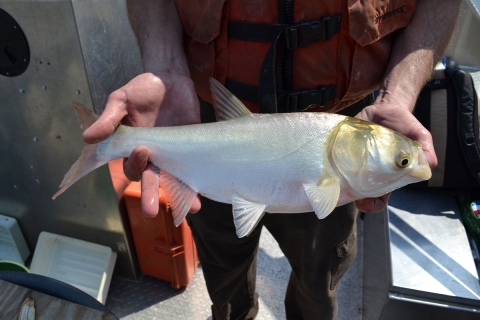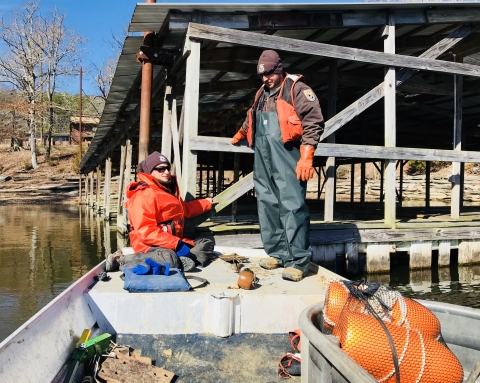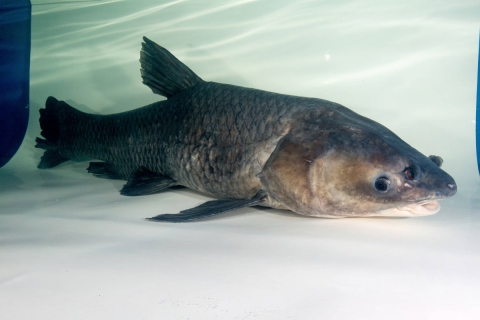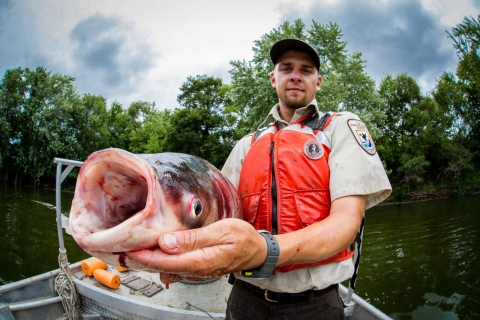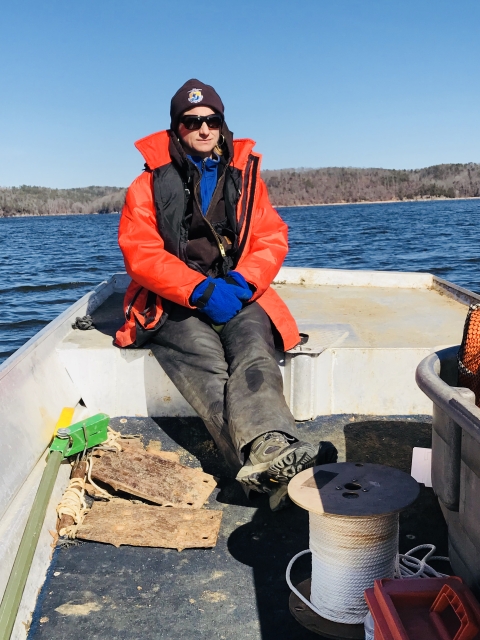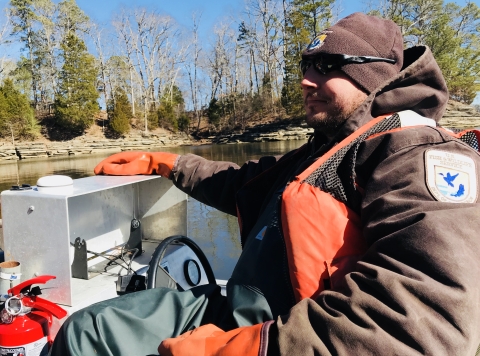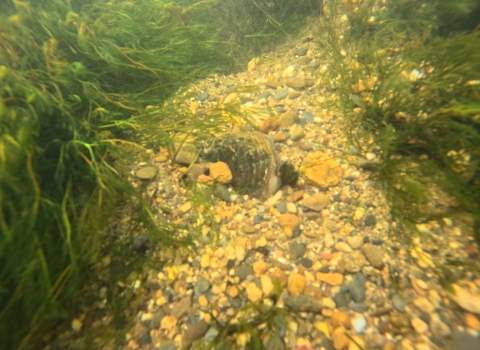Eastport, Mississippi — This stretch of the Tennessee River is considered the most aquatically biodiverse in the nation, teeming with sportfish and at-risk snails and mussels.
Locals boast that Pickwick Lake, where Mississippi, Alabama and Tennessee come together, is “the smallmouth bass capital of the world.” Catfish and buffalo fill commercial angler’s nets. Marinas lining the reservoir’s roads attest to Pickwick’s huge economic impact. Yet the Tennessee River, and a way of life, is under siege.
The silver carp, a voracious, fast-moving and highly invasive species invasive species
An invasive species is any plant or animal that has spread or been introduced into a new area where they are, or could, cause harm to the environment, economy, or human, animal, or plant health. Their unwelcome presence can destroy ecosystems and cost millions of dollars.
Learn more about invasive species ravaging the Upper Mississippi River, has set its sights on the Tennessee, Cumberland, Yazoo and other Southern streams.
Reservoirs downriver in western Kentucky, for example, have been invaded by carp which out-muscle juvenile bass and other filter-feeders for food. Last November 75 silver carp were gill-netted by biologists at Pickwick; other trips, though, turned up no carp. The carp’s DNA was even discovered last fall in Guntersville Lake – 140 miles upriver from Pickwick.
Adding insult to injury, the silver carp, aka “flying carp,” can also jump 10 feet out of the water and smack fishermen, boaters and skiers.
And there’s more: the black carp, another highly invasive Asian import, appears to be following on the heels of the silver carp as it gobbles up mussels and snails.
“They’re progressing this way and they’re going to keep migrating. I don’t care what you do,” said Jimmy Dees, manager of the Eastport Marina, one recent quiet and rainy day. “They’re going to deplete the fish in this lake. The long-term impact could cost a lot of money.”
Not if Angie Rodgers, Dan Schwarz and a platoon of federal and state biologists from the Great Lakes to the Gulf of Mexico have their way. Rodgers and Schwarz, with the U.S. Fish and Wildlife Service (Service), are tracking the carps’ upstream push.
Of immediate concern for the Mississippi-based aquatics experts: an invasion of the Tennessee-Tombigbee Waterway which allows passage to Mobile Bay and the Gulf of Mexico.
Angie Rodgers and Dan Schwartz ready to search for silver carp on Lake Pickwick. Photo by Dan Chapman, USFWS.
“The Southeast is a hotspot of biodiversity, so we’re trying to prevent further declines in at-risk species. It’s a big threat,” said Rodgers, as the bright morning sun cut through Pickwick Lake’s 28-degree cold. “There’s not a magic bullet to get rid of them. It’s just a matter of working together to slow their movement and potential impact.”
“Eradication is the ultimate goal”
Silver, black and two other carp species were imported from Southeast Asia in the 1970s to help clean catfish farms and wastewater treatment ponds of weeds and parasites. Flood waters helped them escape an Arkansas farm. The fish headed up the Mississippi River and into the sinew of tributaries that reaches into 31 states and Canada. Locks and dams don’t always impede their march.
The silver (and bighead) carp’s notoriety mostly centers on tributaries to the Great Lakes and fears that it could damage the region’s multi-billion dollar a year fishing industry. A fisherman contracted by Illinois officials caught a carp last summer 10 miles below Lake Michigan.
Now, it’s the South’s turn to worry. Crappie, bream and black bass abounded across many of the lakes and oxbows in Mississippi’s Yazoo River basin 20 years ago. Fisheries’ biologists surveyed four oxbows last year and discovered that silver carp made up 90 percent of the fish stock.
The fish, which can reach 40 lbs, traveled up the Ohio River and into the Tennessee and Cumberland rivers landing en masse in lakes Barkley and Kentucky about a decade ago. Bass fishermen increasingly complain of fewer landings and blame the carp.
Silver carp. Photo courtesy of the Asian Carp Regional Coordinating Committee.
Researchers at Tennessee Tech, supported financially by the Service, wrote in a recent report that “all empirical and anecdotal evidence points to a rapid expansion of [Asian carp] upstream in both river systems and into their tributaries and successful reproduction by silver carp in the headwaters of Kentucky Lake.”
Tech and Murray State University tagged more than 100 silver carp in Kentucky Lake and 10 in Pickwick. Underwater acoustic telemetry will determine which way the fish are headed. The first round of results is expected by summer.
“We are trying to figure out population distributions within reservoirs,” said Mark Rogers who runs the U.S. Geological Survey’s Cooperative Fishery Research Unit at Tech. “Eradication is the ultimate goal. But suppression and the prevention of carp moving upriver is really what we’re striving for.”
Not far behind, black carp were caught within the last year on lakes Barkley and Kentucky – their southernmost foray to date.
An “underwater rainforest” in peril
Silver and black carp pose a double-barreled threat to a river’s ecosystem. Silver eat plankton – algae and other microscopic organisms – the basic food source for native fish. Black, aka molluscivores, have human-like molars and prey upon snails and mussels, many of which live across the Tennessee River basin and are listed as threatened or endangered.
Asian carp, in general, can consume up to 20 percent of their body weight daily.
“And they are a lot more fecund than our native species, reproducing sooner in life and having more eggs,” said Schwarz, a biologist at the Private John Allen National Fish Hatchery in Tupelo. “Carp may out-compete our fry for food. We may lose an abundance of native species.”
The Tennessee Aquarium, upriver in Chattanooga, and the University of Georgia, released an alarming study last year detailing the Southeast’s most diverse, and imperiled, waterways. Three-fourths of the nation’s fish species and 90 percent of all American mussel and crayfish species live within 500 miles of Chattanooga. The report, funded by the National Fish and Wildlife Foundation, labeled the region’s biodiversity “a veritable underwater rainforest.”
The Tennessee River watershed is blessed with aquatic biodiversity – and cursed with threats from runoff, pollution, development and invasives. The study tallied the total number of fish, crayfish and mollusks across 290 water basins. It also factored how many of those species were at-risk, threatened or endangered.
Pickwick Lake topped the list. Wheeler Lake, 70 miles upriver, came in second.
In all, the Tennessee River system is home to dozens of state or federally protected mussels (including the Southern combshell), crayfish, snails and fish (like the pygmy madtom).
Yet more than mussels and fish are at risk. Ask Johnny Robinson, a commercial fisherman who gill-nets across Pickwick Lake.
“We’ve seen a bunch of carp; every year it gets worse and worse,” said Robinson from Iuka, Mississippi who wholesales fish to Memphis and other cities across the region. “A lot of days we’ll catch 20 or 30 of them. They stay in the same type water that buffalo do, so we catch less and less buffalo and more and more carp.”
Locals also worry the sportfishing industry will suffer if the carp conquer Pickwick.
“They got a big problem in Kentucky Lake and ours is getting pretty bad too,” said Roger Stegall, a fishing guide from Iuka renowned for landing large-sized smallmouth bass. “Seems like they’re real calm ‘til sunny days and then they come to the surface and you see ‘em in big schools. They are a nuisance, recreation-wise.”
Dangerous too. Boat motors and other loud noises spook silver carp who then jump clear out of the water. Anglers and skiers, increasingly, tell of the big fish flying into their boats or knocking them over. A decade ago a silver broke the jaw of a teenager riding an innertube on Lake Chicot in Arkansas. Stegall was guiding on Lake Ferguson three years ago when a 30-pound carp jumped over his boat.
“We’ve still got good fishing here, but these jumping carp is what I’m really afraid is going to hurt our lake as far as tourism and fishing,” said Robinson, the wholesaler. “If things get as bad as some places up north you’ll hardly be able to run a boat without them jumping in.”
“The front line in the war”
Rodgers and Schwarz, the Service biologists, idled the jon boat in Indian Creek, a cove feeding into Pickwick Lake. Ten silver carp were captured, tagged and released here last November. Rodgers checked a telemetry gauge that tracks the carps’ movements.
“This is the front line in the war on silver carp for Tennessee and the Tenn-Tom waterway,” she said, as a blue heron passed overhead.
Fish and Wildlife and other federal agencies work closely with states to combat the carp. It’s a maddening and expensive challenge. The U.S. Corps of Engineers, for example, recommends spending $275 million – electric barriers, noise generators, a new lock and channel – to keep Mississippi River carp from the Great Lakes.
In addition to research by Tennessee Tech, the state, the Service and USGS are considering “noise barriers” at various dams along the Tennessee River. High frequency sound waves would be blasted at the carp to keep them from advancing further upriver.
Tennessee created a legislative task force to bring attention to the carp. The commission directed fisheries officials to subsidize commercial fishermen and wholesalers, maybe paying the former five cents per pound and the latter a few pennies. Kentucky runs a similar, and successful, program that pays fishermen a nickel per pound to switch from catfish and buffalo to Asian carp.
“I’m most concerned with the fish getting into eastern Tennessee where we don’t have them now,” said Frank Fiss, fisheries chief for the Tennessee Wildlife Resources Agency. “We still have an opportunity to slow them down and are using all available means.”
